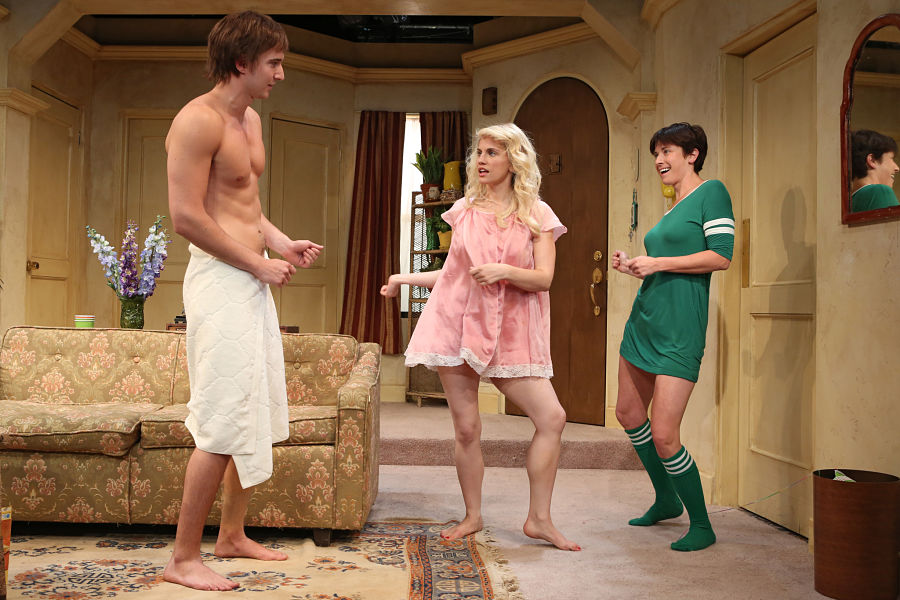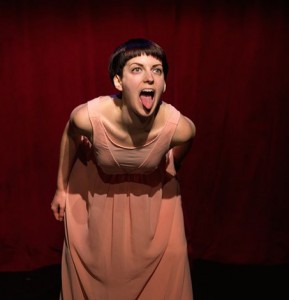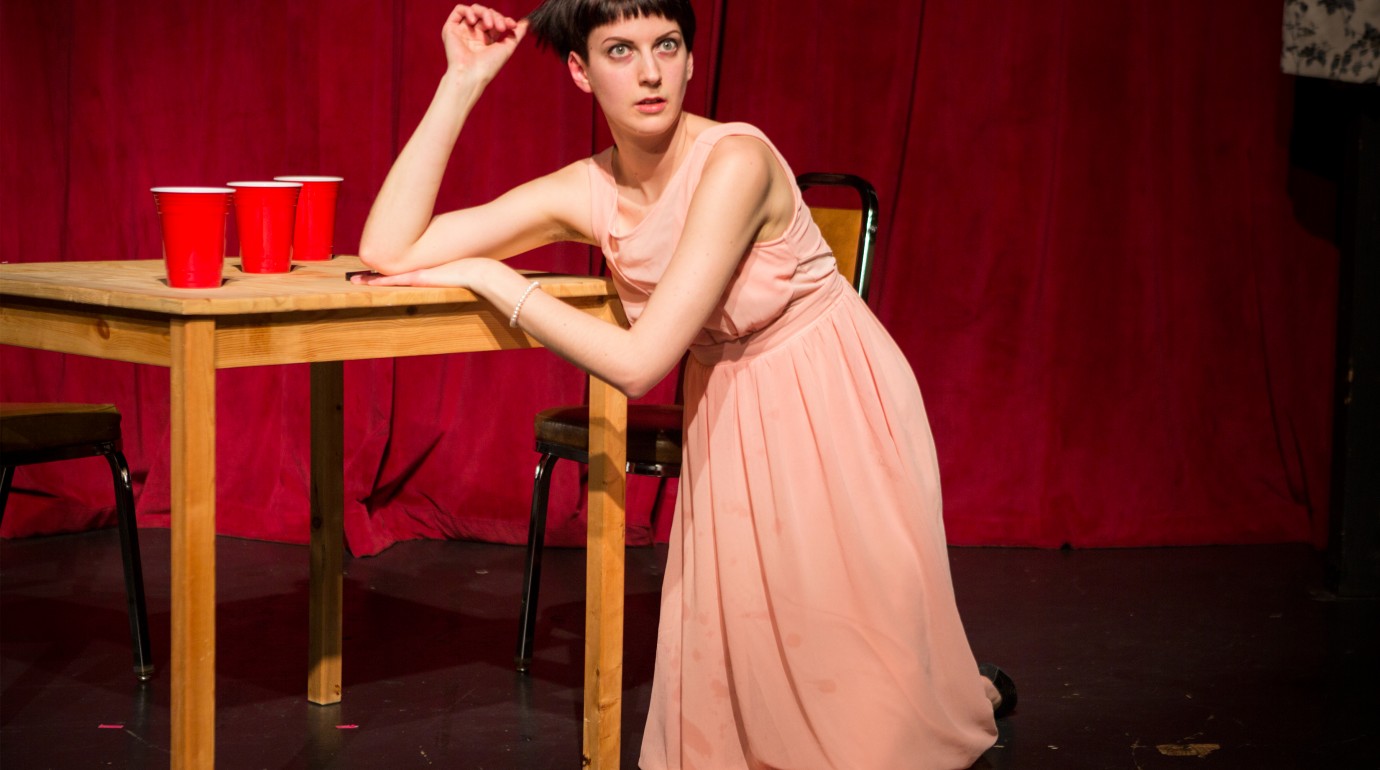In That’swhatshesaid, the 72 pages of Matthew Lopez’s play The Whipping Man flip by—literally. As this happens, performer Erin Pike runs around the stage searching for her place. There are no female characters in The Whipping Man, so she finds no place, which is the point the artists staging it are trying to make—not about Lopez’s play, which they have no issue with per se, but as a representative of the dearth of female voices onstage in general.
That’swhatshesaid, performed for a four-night run last week in a 50-seat venue at Gay City Arts in Seattle, is a new work inspired by a growing frustration with the role of women in theatre, and constructed from the words of leading playwrights. Three young queer artists—director Hatlo, playwright Courtney Meaker, and creator/performer Erin Pike—worked for two years to make it. In setting out to draw attention to the ways in which women’s voices are rendered and their bodies presented onstage, they took pieces of dialogue and stage directions from the 11 plays listed by American Theatre as the most-produced plays of the 2014-2015 season. The Whipping Man was on the list, as were David Ives’s Venus in Fur, Christopher Durang’s Vanya and Sonia and Masha and Spike, Nina Raine’s Tribes, and Joshua Harmon’s Bad Jews. Of the 11 plays, only 2 were by women (the other was Amy Herzog’s 4000 Miles).
Because, as a review in The Stranger indicated, the artists used copyrighted material from Harmon’s play in particular, they encountered a new and unexpected frustration: a cease-and-desist letter from Harmon’s representatives at the licensing company Samuel French, delivered shortly before curtain on the second night of their four-night run. “Flabbergasted” by its receipt, the artists felt it was too late to cancel the show, so they proceeded to perform with a redacted text, cutting out any material from Bad Jews. But the pressure didn’t stop with the show’s closure: Even after the curtain came down on its last performance, more cease-and-desist letters arrived on behalf of other playwrights on the list (including Lopez).
To understand the copyright implications and the rights of the artists on both sides of this dispute, it’s important to look at what That’swhatshesaid does and does not do. I spoke with Hatlo, Meaker, and Pike to suss out how the show came about, what their intent in making it was, and what exactly they put onstage (they also sent me a script, color-coded to show which excerpts came from which plays). I also spoke with intellectual property law attorneys about the copyright issues raised by this show and sources at Samuel French and Dramatists Play Service, which represent some of the plays on the list.
This show was born of the increasing disillusionment Pike felt as an actor, “realizing that the roles I was auditioning for were very problematic and not very meaningful to the plot.” She watched female friends perform in plays and “they would maybe be on stage for 10 minutes out of the show. Or they were onstage longer, but they were serving as a prop role compared to the men.”
Pike and Meaker began to brainstorm around these ideas to find a way to capture the discontent they were feeling. To focus their efforts, they looked to American Theatre‘s annual most-produced plays list, “not to condemn any one playwright,” Meaker said, but to start the conversation around what is ultimately “a systemic issue.” The AT list became “data about how women are presented onstage,” said Hatlo.

For Hatlo, the endeavor boiled down to showing “what audiences are seeing women do the most onstage. What are the words that they are saying? How are their bodies moving? Who are they in relation to other people onstage?”
The idea was not to stage these well-known plays—all of which, except for Tribes, have been produced in Seattle—but to extract the female characters from the plays and look at those voices and experiences in isolation to see what the landscape of female performance looked like collectively. To accomplish that, the three artists pulled all the lines and stage directions relating to the female characters from the 11 plays and looked for commonalities and motifs. Where they saw patterns or related material, they created thematic sections, taking bits and pieces from different works. The result is a compilation of verbal outbursts and tirades; of instances of women giving up or selling themselves short; of questions female characters are allowed to ask; and of women apologizing.
Hatlo said that one of their favorite scenes is the “compilation of all the stage directions of what women were directed to do.” Hatlo explained, “It’s totally in voiceover; it goes rapid-fire in succession. It involves [Erin] crying maybe 7 or 8 times, separately and in different places. Erin uses a tear bottle to achieve this. It’s hilarious physical comedy but it’s also exhausting.”
Pike described these isolated female voices, once pulled out of their native texts, as “very flat. I feel like I’m busting my ass to make them whole. I actually feel that in both acts.” (Act One contains material from the 9 plays on the list written by men, and Act Two the 2 plays written by women.) “That’s not to say that these roles would not be fun to play,” Pike conceded. “I’m sure you can have a blast in many of them. When you put them all side by side, the toll of the flatness becomes very high. Especially night after night.”
This accretive lens, the artists argue, is critical to the work. Said Hatlo, “I don’t want to indict playwrights; that’s not the goal. The goal is for audiences to understand what this accumulation looks like. I want to see if they can feel what it feels like.”
Said Meaker, “This is a play about all of these plays together, and what they say as a collective whole about where we are in the American theatre scene.”
Of course, because That’swhatshesaid uses pieces of writing by other playwrights, the question of copyright infringement is a live one. No one would argue that all the playwrights on the list don’t have a right to control the licensing of performances of their plays. But copyright is not an absolute right.
“Copyright law restricts free speech,” said Lawrence Iser, an intellectual property and entertainment attorney at KWIKA Law. “There is that tension between the First Amendment and copyright, and the way that tension is resolved is through fair use.”
Fair use provides for a right to criticize or comment on copyrighted works; often to criticize or comment, one needs to cite the copyrighted work, at least in part, to get the point across. But that kind of use has limits. Explained Iser: “Your ability to utilize the fair use doctrine depends on the four fair use factors, which define whether or not it is truly a fair use or whether it is an infringement.”
The four factors enumerated in the U.S. Copyright Act include “(1)…the purpose and character of the use…; (2) the nature of the copyrighted work; (3) the amount and substantiality of the portion used…; and (4) the effect of the use upon the potential market for or value of the copyrighted work.”
Often the courts will spend a significant portion of their fair use analysis to determine if the purpose and character of the use is “transformative.” The Supreme Court’s 1994 decision on 2 Live Crew’s “Oh Pretty Woman” stated that “the central purpose of this investigation is to see…whether the new work merely ‘supersede[s] the objects’ of the original…or instead adds something new, with a further purpose or different character, altering the first with new expression, meaning, or message.”
In 2015, this analysis was used by the District Court in New York, which found that playwright David Adjmi’s play 3C transformed the copyrighted material from “Three’s Company” through parody, “turn[ing] ‘Three’s Company’s’ sunny 1970s Santa Monica into an upside-down, dark version of itself.” Attorney Bruce E. H. Johnson of Davis Wright Tremaine represented Adjmi in that action.
Often fair use is discussed in the same breath as “parody,” but, as Johnson explained, “Parody is a separate category from criticism [in fair use], but both of them ultimately involve a critique of the underlying work.”

Johnson pointed out in the Adjmi decision that the court called 3C a “deconstruction” of “Three’s Company.” Although he has not seen the script of That’swhatshesaid, based on press reports he believes that something similar may apply. “[The Seattle artists] have deconstructed each of the works to say something completely different and to point out a glaring issue addressing the voice of women in modern society.”
Iser agrees. What the makers of That’swhatshesaid have done sounds to him like a matter of “commenting on the plays themselves, commenting on the authors of the plays, at some level commenting on theatre in general and the state of theatre in our country.” He continued: “They are not there to reproduce the plays in a manner that’s going to hurt the box office for the plays.” He said it sounds like a “very thoughtful piece, the purpose of which is to demonstrate the plight of women in the major stage plays of our time.”
Since the controversy erupted, the artists behind That’swhatshesaid have sought the services of attorney Jeffrey Nelson of Miller Nash Graham & Dunn, who is representing them pro bono. Nelson, who is the chair of the Washington Lawyers for the Arts, has reviewed the script of That’swhatshesaid and stated unequivocally, “Our position is that this work does not require permission from any of the playwrights whose content was used because it does qualify as fair use. We believe that [this is transformative.] The work takes a small amount of text from each of those scripts, slices them up, reconfigures [them.]” He concluded: “That performance creates an entirely new work with an entirely new purpose which comments upon the representation of women in the industry.”
After closing, the cease-and-desist letters received by That’swhatshesaid’s creators included another from Samuel French with respect to The Whipping Man, and one from Dramatists Play Service with respect to plays by Jon Robin Baitz (Other Desert Cities), Christopher Durang, David Ives, Nina Raine, and John Patrick Shanley (Outside Mullingar).

Peter Hagan, president of Dramatists Play Service, explained, “Our role is simply to make sure that the work is paid for when used and licensed appropriately.” He continued, “We are the representatives of the playwright and make sure their work is presented with the playwright’s permission. In this particular situation, no permission was ever sought by Courtney Meaker or Erin Pike or anyone on their behalf.”
Hagan has received a copy of the script through the artists’ attorney, Jeffrey Nelson, and based on that, he said that DPS’s position has not changed. Hagan cited the introduction that appears in the script of That’swhatshesaid: “‘Everything that is said and every action spoken over voiceover with the exception of a line…is taken directly out of a play listed below,’ and they list the plays that were used. ‘This is a work that deliberately takes lines and actions out of context and inserts them into a new world. We claim no ownership of the material presented below.’” Hagan concluded, “Regardless of whether they claim no ownership of the material, the fact is that the material is presented without any permission of the people who do own that work.”
When asked about fair use claims, Hagan said, “Fair use is a very fluid thing. There’s a great gray area in fair use. Our position is when something like this happens, we say, ‘You can’t do this,’ and the producer or the presenter or writer says, ‘No, this is fair use,’ we will take that back to the writer and to the writer’s agent and say, ‘Do you want to take this to the next level and litigate? Then this is your choice.’”
For its part, Samuel French’s executive director, Bruce Lazarus, issued a statement on the matter: “Samuel French’s responsibility is to the playwrights we represent. Erin Pike and Courtney Meaker did not seek permission from us for the use of material by authors published by Samuel French. We consider this to be copyright infringement. We have instructed the creators to cease-and-desist all productions of That’swhatshesaid.”
Lazarus continued: “With regards to the political commentary put forth by the creators, we express no personal opinions. To be clear, we have no desire to suppress the point of view Courtney Meaker and Erin Pike put forth in their play. However, we stand by the rights of the authors we represent and insist that the creators of That’swhatshesaid seek appropriate permissions before proceeding.”
Did Hatlo, Pike, and Meaker have any second thoughts about their approach along the way, or think about contacting the playwrights for permission? On the contrary, they believed that seeking permission was unnecessary because of the nature of the usage, and in a response to French and DPS, Nelson reiterated this position and asked the playwrights and their reps to reconsider their objections.
Pike said that her research into the legal precedents convinced her that That’swhatshesaid “was obvious parody, obvious transformational work.” Yes, she said, “It definitely crossed my mind, if someone wanted to be a huge asshole or was so protective of their work that they didn’t want anyone whispering its name, that they could potentially have a problem with this idea.”
Meaker, a playwright whose worked has been produced at various Seattle theatres, said she understands why fellow writers may be concerned.
“It’s completely understandable in a certain regard where people are worried their plays are being produced without their permission,” she said. “But that’s not happening.” It couldn’t be happening, in fact, as Meaker points out: The 11 plays in question would take roughly 24 hours to perform in their entirety; That’swhatshesaid runs just 70 minutes. “So the amount of time we are spending with each of these—the dialogue is so minimal,” Meaker says. Even those who know the plays in question, she says, would find them “very unrecognizable.”
The artists say they’re planning to press forward, but they hope this conversation can be broader than a dispute about copyright. As Meaker says, “I want [the] narrative to change. I want this system to be better.” Says Hatlo, “More than anything our goal is to have people see the show because we think it’s an important idea. It’s an incredible conversation starter.”


